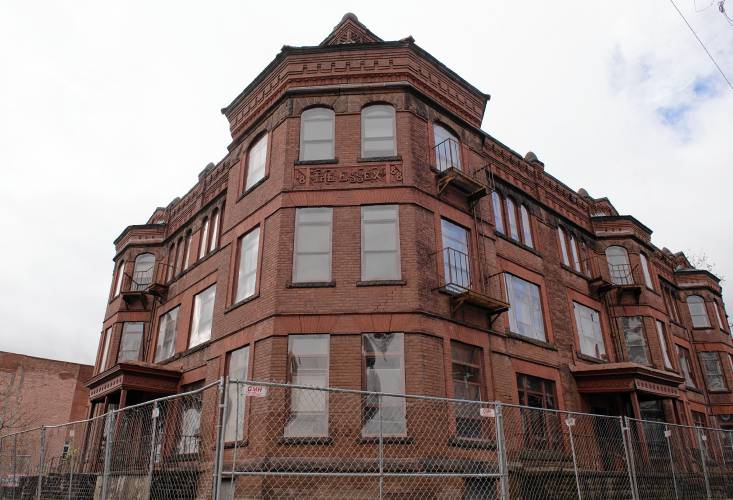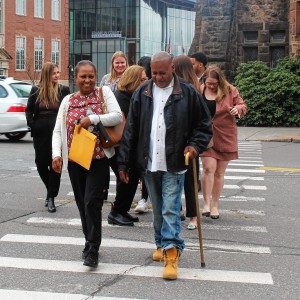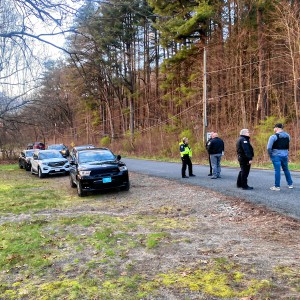Amid housing crisis, Massachusetts subsidizes market-rate units

The Essex building in Holyoke is being redeveloped into affordable housing, a project that has received various grant funding and is being overseen by Way Finders in Springfield. FILE PHOTO
| Published: 11-13-2023 4:47 PM |
BOSTON — A housing development program for Massachusetts’ 26 gateway cities that was a key part of the new tax relief bill is raising questions about what is “market rate.”
The Housing Development Incentive Program (HDIP) has subsidized millions of dollars to create housing units in the commonwealth. But a report by the Massachusetts Law Reform Institute argues the program “subsidizes only unaffordable housing, with rents that can be shockingly high and with no limits on increases,” including a Malden Center development where one-bedroom units can cost up to $4,654 a month.
But supporters defend the program, which operates largely outside Greater Boston, as necessary to promote mixed-income communities.
Amidst a growing housing crisis in Massachusetts, the recent tax relief bill granted $327 million over the next 10 years to HDIP for tax credits to develop housing containing at least 80% market rate units.
The statute defines market rate as units that are “priced consistently with prevailing rents or sale prices in the municipality.” Despite the need for 175,367 units of affordable housing in Massachusetts, the legislation is notably silent in defining affordability.
“Market rate sounds so innocuous,” said Judith Liben of MLRI. “Well, think of the Massachusetts market, and you know that means it means very high rents.”
The National Low Income Housing Coalition reported that an hourly wage of $31.98 is needed to afford a two-bedroom market rate unit in eastern Worcester County. Renters, however, are estimated to earn on average $18.22 per hour. This discrepancy puts market rate housing rents out of reach for many in Worcester.
Upon facing eviction, Dave Vespucci, a then 74-year-old man who had lived in Worcester for over 20 years, told GBH News, “Prices are slowly squeezing out all the poor people.”
Article continues after...
Yesterday's Most Read Articles
 Franklin Tech student welds artistic bench for French King Bridge
Franklin Tech student welds artistic bench for French King Bridge
 On The Ridge with Joe Judd: What time should you turkey hunt?
On The Ridge with Joe Judd: What time should you turkey hunt?
 State records show Northfield EMS chief’s paramedic license suspended over failure to transport infant
State records show Northfield EMS chief’s paramedic license suspended over failure to transport infant
 Former Greenfield man granted new trial after 1995 murder conviction, walks free
Former Greenfield man granted new trial after 1995 murder conviction, walks free
 Police report details grisly crime scene in Greenfield
Police report details grisly crime scene in Greenfield
 Formed 25,000 years ago, Millers River a historic ‘jewel’
Formed 25,000 years ago, Millers River a historic ‘jewel’
Last month alone, 3,120 eviction cases were filed in Massachusetts.
To Liben, HDIP “ignores the dire affordable housing crisis that the commonwealth is in.”
“If you look at HDIP and ask: where is this commonwealth’s need for housing? Who needs housing? Is it any housing that we want? Like 12,500 units that aren’t affordable at all? No portion of them is affordable? Is that what we want? Do we care about number of units for housing rather than what kind of units available to whom?” she asked.
Another feature of HDIP is that only developers in gateway cities are eligible to receive the tax credits. “The 26 cities are enormously different cities,” Liben said. “While the need to revive downtowns and have more middle-class people come live in what are fairly low-income communities might be true for some gateway cities, HDIP doesn’t differentiate at all between Malden, Quincy, Lowell, or Fall River.”
Or Chelsea, according to Alexander Train, the Suffolk County city’s director of housing and community development, who also faulted HDIP’s treatment of gateway cities, which also include Springfield, Holyoke and Pittsfield.
Train said Chelsea’s vacancy rate is below 4%, there is an “extreme scarcity” of affordable housing, and the median household income is lower than the state’s median. Furthermore, more than 50% of renters are cost burdened, meaning they pay more than 30% of their income on housing.
Train also stated that residents work multiple jobs and need to reside close to their employment centers and public transit, both of which, Train said, “have seemingly become a luxury in the Boston area.”
Train said HDIP’s requirement of at least 80% market rate units does not align with the needs of Chelsea.
“We can’t do [HDIP projects] right now unless we do projects with 20% or less affordable units. And that is not lining up with the needs of our residents nor residents of the Greater Boston region.”
Andre Leroux, the director of the Gateway Hubs Project at MassINC, acknowledged the differences in the housing markets across the gateway cities. Nonetheless, he said that HDIP still “works the way it’s supposed to work, because in the analysis that I’ve done of all of the projects that have been funded by HDIP, 93% of all of the projects have been outside of the Boston area.
“In the metro Boston area, you can actually use HDIP to increase the amount of affordability in a project,” he added.
Peter Dunn, chief development officer of the Executive Office of Economic Development of Worcester, the city that Liben called the “poster child of HDIP’s problems,” stated that HDIP projects in Worcester were “historically … 100% market rate.” Worcester’s newest HDIP project, however, provides for the 20% cap of affordability allowed by statute. Dunn suggested that it is best to leave the decisions of affordability to the locality.
“I know in Worcester we’re in a different place in terms of our market than we were five or 10 years ago, and I can imagine a lot of other gateway cities might still be in that kind of market condition,” Dunn said. “So, I think it really is best for the local community to figure out what composition of a project is best for them and whether it has that local support rather than having it be totally prescribed or mandated by the state level, because every community is different.”
Leroux saw forgoing affordability altogether as an asset of HDIP, “because every community deserves to have a mix of incomes.”
“Otherwise, through policy, we’re promoting segregation, economic segregation, which is often also racial segregation,” Leroux said. “I find it really strange to be in a situation where some progressive housing organizations or social justice groups are trying to limit the kinds of housing that you can build in communities where low-income people live: are you saying that you only can have low-income people in these communities?”
Keith Fairey, president and CEO of housing nonprofit Way Finders in Springfield, discussed the importance of creating housing for a mix of incomes in a city like Holyoke, which have been “devastated by disinvestment and abandonment.”
“The city leaders in Holyoke don’t want people to leave Holyoke when their incomes increase: they want people to stay in Holyoke even when they become more economically mobile,” Fairey said. “And HDIP provides the opportunity to do market rate housing alongside affordable housing, because the economics and the finances of developing housing here — whether it’s affordable housing or market rate housing — don’t work very well without a subsidy. The rents or sales would not pay for the development costs on their own.”
Recent Census data reveals that Massachusetts has lost around 50,000 residents. Fairey is hopeful that an increase in housing options in cities like Holyoke — which at its peak had 60,000 people, but today has 37,000 people — can “fill up the delta that we’ve lost in terms of our population in the commonwealth.”
Jaimee Francis writes for the Recorder from the Boston University Statehouse Program.

 ‘Stand up for our democracy’: Voting rights activist John Bonifaz keynote speaker during Law Day event
‘Stand up for our democracy’: Voting rights activist John Bonifaz keynote speaker during Law Day event Doors open at Tilton Library’s temporary home at South Deerfield Congregational Church
Doors open at Tilton Library’s temporary home at South Deerfield Congregational Church DA to announce breakthrough in 1989 unsolved homicide in Warwick
DA to announce breakthrough in 1989 unsolved homicide in Warwick Mohawk Trail Regional School looks to leave audiences humming, smiling at spring musical
Mohawk Trail Regional School looks to leave audiences humming, smiling at spring musical
